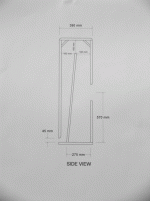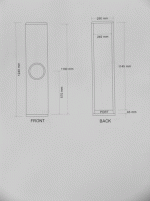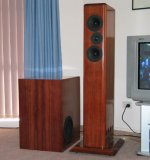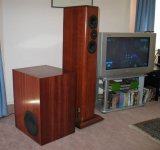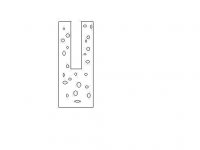Scott,
what sort of low pass filter would you recommend for this sub? I have a 4th order Linkwitz-Reily active filter on the Ariels that has a spare output I could use for the subwoofer. In any case, what cutoff freq would suit the sub design you have come up with?
what sort of low pass filter would you recommend for this sub? I have a 4th order Linkwitz-Reily active filter on the Ariels that has a spare output I could use for the subwoofer. In any case, what cutoff freq would suit the sub design you have come up with?
The active filter you have on the Ariels should probably do the job, at least at first. I'd roll them off above 75Hz -80Hz maximum. The Ariels should be fine above that. There are probably better filters, but they are not a speciality of mine, so I'll leave it open to other suggestions from the other guys, who know more about them than I do.
Regards
Scott
Regards
Scott
OK, I'll start with about 75Hz and take it from there. BTW, how is the weather in Yorkshire at the moment? Reasonably warm I guess? Lovely part of the world.
Mild enough. Quite nice as the rain we've hed has tended to come at night. Most of the apple blossom & even the hearther up on the mooors etc is out or coming out now, so it's all looking rather attractive.
Cheers
Scott
Cheers
Scott
I bought The SEAS H1208 driver for the sub today. I would like to attach a plan of the enclosure I have come up with to implement Scott's design.
I guess the easiest way will be to draw the plans, photograph them and attach a .jpg file. Is there an easier way?
I guess the easiest way will be to draw the plans, photograph them and attach a .jpg file. Is there an easier way?
stereo would be good, but isn't going to be an option with my lounge room setup.
I am planning to use a 240W integrated subwoofer plate amp. This amp has adjustable bass boost (by changing a couple of resistors).
I was wondering whether the modelling software you used outputs a frequency plot of the driver/enclosure combination? It might be useful for deciding how much boost and at what frequency is required.
I am planning to use a 240W integrated subwoofer plate amp. This amp has adjustable bass boost (by changing a couple of resistors).
I was wondering whether the modelling software you used outputs a frequency plot of the driver/enclosure combination? It might be useful for deciding how much boost and at what frequency is required.
Hello,
Has been a while since I contributed to this thread, but I have just completed a pair of the bass units as recommended by Lynn Olson.
http://www.nutshellhifi.com/ME2txt.html#swactive
Box construction is 25mm construction grade plywood with extensive internal bracing. As I had difficulty veneering the Ariels, I used a different technique with these cabinets. I used a 1.5mm plywood with a jarrah veneer face. I applied this with regular wood glue and am happy with the results. Some minor deviations from the plans were that I ended up omitting the extended base of the box under the speaker drivers as it was going to be too problematic to veneer it.
Crossover is slightly different to that recommended also. I am using a Linkwitz Riley 4 active crossover at 80hz for both the Ariels and the Woofer units (Lynn recommends a 1st order passive for the Ariels and a 3rd order active for the woofers).
When building these I refered to them as "subwoofers", but I think that it is more accurate to describe them as woofer units. As an experiment, I did try constructing a modest Linkwitz transform circuit to boost the bass, but was not that happy with the result. I think that the drivers (Scan Speak 25W/8565-01) are more of a woofer, as it has limited xmax compared to a true subwoofer driver.
I am still experimenting with placement and the level settings of the active crossover, but I am happy with the results so far.
As an aside, I have listened to these while listening to a few movies, and while it does improve the bass response of the Ariels immensely, they do bottom out while playing very bass heavy scenes (Nemo whale and Darla tapping tank) at high volumes. For fun I am thinking of building a true subwoofer that will be used exclusively for home theatre.
Chris
Has been a while since I contributed to this thread, but I have just completed a pair of the bass units as recommended by Lynn Olson.
http://www.nutshellhifi.com/ME2txt.html#swactive
Box construction is 25mm construction grade plywood with extensive internal bracing. As I had difficulty veneering the Ariels, I used a different technique with these cabinets. I used a 1.5mm plywood with a jarrah veneer face. I applied this with regular wood glue and am happy with the results. Some minor deviations from the plans were that I ended up omitting the extended base of the box under the speaker drivers as it was going to be too problematic to veneer it.
Crossover is slightly different to that recommended also. I am using a Linkwitz Riley 4 active crossover at 80hz for both the Ariels and the Woofer units (Lynn recommends a 1st order passive for the Ariels and a 3rd order active for the woofers).
When building these I refered to them as "subwoofers", but I think that it is more accurate to describe them as woofer units. As an experiment, I did try constructing a modest Linkwitz transform circuit to boost the bass, but was not that happy with the result. I think that the drivers (Scan Speak 25W/8565-01) are more of a woofer, as it has limited xmax compared to a true subwoofer driver.
I am still experimenting with placement and the level settings of the active crossover, but I am happy with the results so far.
As an aside, I have listened to these while listening to a few movies, and while it does improve the bass response of the Ariels immensely, they do bottom out while playing very bass heavy scenes (Nemo whale and Darla tapping tank) at high volumes. For fun I am thinking of building a true subwoofer that will be used exclusively for home theatre.
Chris
Attachments
Scott ,
I noticed your quote re the MLTL Ariel.......
".25lbs ft^3 of Dacron (or similar) stuffing from the top to 4" below the lower driver"....
Well my question's are :
Is this the ONLY stuffing required ? Is the rest of the enclosure left as bare timber ?
Would adding bitumin sheets & foam (like many other designs) improve things overall or is it a waste ?
Is it worth adding a bracing "shelf" or two to the enclosure ?
Thanks
Andrew
I noticed your quote re the MLTL Ariel.......
".25lbs ft^3 of Dacron (or similar) stuffing from the top to 4" below the lower driver"....
Well my question's are :
Is this the ONLY stuffing required ? Is the rest of the enclosure left as bare timber ?
Would adding bitumin sheets & foam (like many other designs) improve things overall or is it a waste ?
Is it worth adding a bracing "shelf" or two to the enclosure ?
Thanks
Andrew
Hi Andrew
Bracing is good. Best way I know is the method Dave planet10 uses. Here's the Small Thor I designed, that Dave drew: a picture speaks a thousand words!http://www.diyaudio.com/forums/attachment.php?s=&postid=902727&stamp=1146169099 You can see the cheese bracing side to side (off centre) and another that braces the drivers to that internal bracing panel. Almost completely erradicates panel resonance.
As for the stuffing, yes, just the upper part. In a quarter wave resonator, the point of maximum velocity for the low frequencies occurs at or near the terminus of the line. Stuffing is always at its most effective where air velocity is highest. And given that Ariel is no LF champ, we don't want to be absorbing the LF resonance of the line. So, we leave the lower part of the cabinet empty of stuffing, so the fundamental resonance we wished to generate is preserved, and stuff the upper part, where the point of maximum velocity of unwanted higher (harmonic) resonances occurs, and we can most effectively damp them out without affecting the rest. You could add some damping panels to the upper part if you like. They shouldn't do any harm, but I'd leave the lower part as-is.
Hope this helps?
Regards
Scott
Bracing is good. Best way I know is the method Dave planet10 uses. Here's the Small Thor I designed, that Dave drew: a picture speaks a thousand words!http://www.diyaudio.com/forums/attachment.php?s=&postid=902727&stamp=1146169099 You can see the cheese bracing side to side (off centre) and another that braces the drivers to that internal bracing panel. Almost completely erradicates panel resonance.
As for the stuffing, yes, just the upper part. In a quarter wave resonator, the point of maximum velocity for the low frequencies occurs at or near the terminus of the line. Stuffing is always at its most effective where air velocity is highest. And given that Ariel is no LF champ, we don't want to be absorbing the LF resonance of the line. So, we leave the lower part of the cabinet empty of stuffing, so the fundamental resonance we wished to generate is preserved, and stuff the upper part, where the point of maximum velocity of unwanted higher (harmonic) resonances occurs, and we can most effectively damp them out without affecting the rest. You could add some damping panels to the upper part if you like. They shouldn't do any harm, but I'd leave the lower part as-is.
Hope this helps?
Regards
Scott
Chris - excellent looking speakers. I am glad you like them. Thanks so much for sharing, excellent photos.
Lovely finish isn't it. The Ariel was always an elegant design, and with this quality veneer, it looks even more so with those big radii. Great stuff.
any updates from zix on his ariel - mltl project?
I've had the vifa and scanspeak drivers and crossover kit from northcreek sitting in their original box for a few years now (postponing the project of building the cabinets for the ariels).
The simpler mltl construction would be ideal for me (with more kids in diapers and not much free time these days)
Scottmoose, I'm having a bit of trouble picturing the box in my simple minded head, especially how the side to side brace is configured with respect to the front to rear brace. The way I see it, the rear chamber is completely sealed off (which can't be right).
Is the side to side bracing swiss cheesed as well?
Also, should the drivers be in a vertical line as in the thor drawing posted or...should they be in the d'appolito configuration as in the ariel schematics?
And how about the assymetrical routing of the radii on the front face of the boxes?
Thanks (and sorry for the simple questions as I am a beginner to this field but fairly handy with tools).
Storch
I've had the vifa and scanspeak drivers and crossover kit from northcreek sitting in their original box for a few years now (postponing the project of building the cabinets for the ariels).
The simpler mltl construction would be ideal for me (with more kids in diapers and not much free time these days)
Scottmoose, I'm having a bit of trouble picturing the box in my simple minded head, especially how the side to side brace is configured with respect to the front to rear brace. The way I see it, the rear chamber is completely sealed off (which can't be right).
Is the side to side bracing swiss cheesed as well?
Also, should the drivers be in a vertical line as in the thor drawing posted or...should they be in the d'appolito configuration as in the ariel schematics?
And how about the assymetrical routing of the radii on the front face of the boxes?
Thanks (and sorry for the simple questions as I am a beginner to this field but fairly handy with tools).
Storch
Ask away. No question is stupid if you need to know the answer to it.
The side to side bracing is also of the Swiss cheese variety. There's no chamber of any kind at all: it's just a straight enclosure that resembles a reflex box (though doesn't act that way) with some hefty cheese bracing to kill any panel and driver resonances. Place the side to side bracing off-centre -about 2/3 of the way back should do it. You could use shelf bracing as an alternative, but this is much, much better. Takes a while to cut the many holes, but it's not difficult -just time consuming and a bit tedious, but well worth it in the end.
The drivers should be exactly as Ariel is in the offset D'Appolito configuration. If you wish to do the asymetrical radii on the front, then there's no harm in it.
Hope that helps
Best
Scott
The side to side bracing is also of the Swiss cheese variety. There's no chamber of any kind at all: it's just a straight enclosure that resembles a reflex box (though doesn't act that way) with some hefty cheese bracing to kill any panel and driver resonances. Place the side to side bracing off-centre -about 2/3 of the way back should do it. You could use shelf bracing as an alternative, but this is much, much better. Takes a while to cut the many holes, but it's not difficult -just time consuming and a bit tedious, but well worth it in the end.
The drivers should be exactly as Ariel is in the offset D'Appolito configuration. If you wish to do the asymetrical radii on the front, then there's no harm in it.
Hope that helps
Best
Scott
storch, no news yet on the mltl boxes. They are put together but do not play, as the filters are not finished yet. Actually yesterday was the first day I had a look at the filters again since sometime in april and managed to do a little work on them.
Life gets in the way sometimes - small children being only one of the reasons...
I have not planned any bracing of the box - I guess the box dimensions would need to be corrected in that case, if only a little. If I start doing that at this stage, there is a risk they will never be finished...
Life gets in the way sometimes - small children being only one of the reasons...
I have not planned any bracing of the box - I guess the box dimensions would need to be corrected in that case, if only a little. If I start doing that at this stage, there is a risk they will never be finished...
thanks zix, scottmoose
looks like, time permitting, I might be able to get these speakers started soon
so the side bracing would look something like this with the slot for accomodating the front to back brace?
(size of slot is exaggerated but is only the thickness of the bracing material)
thanks again
storch
looks like, time permitting, I might be able to get these speakers started soon
so the side bracing would look something like this with the slot for accomodating the front to back brace?
(size of slot is exaggerated but is only the thickness of the bracing material)
thanks again
storch
Attachments
- Home
- Loudspeakers
- Multi-Way
- Ariel construction
